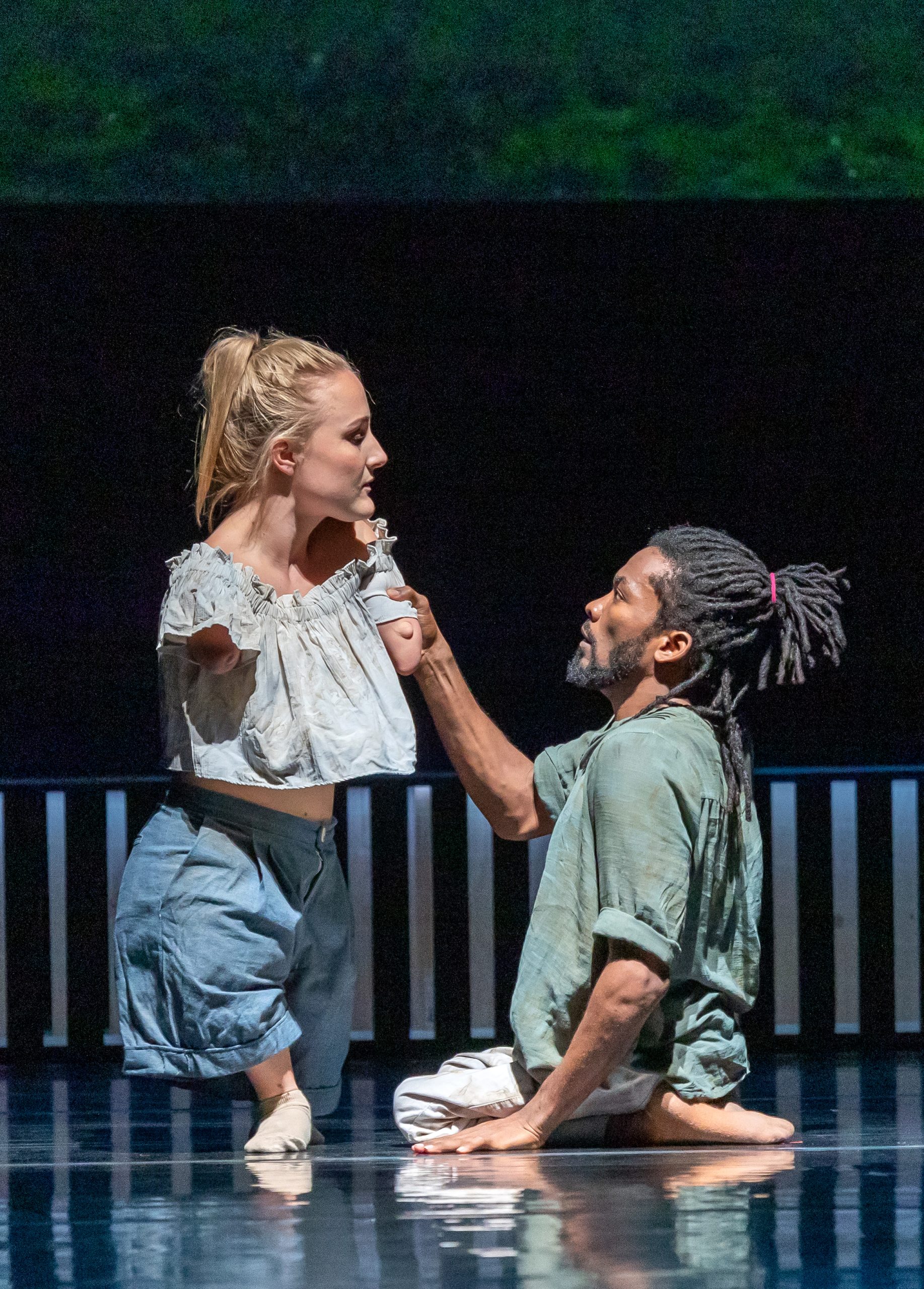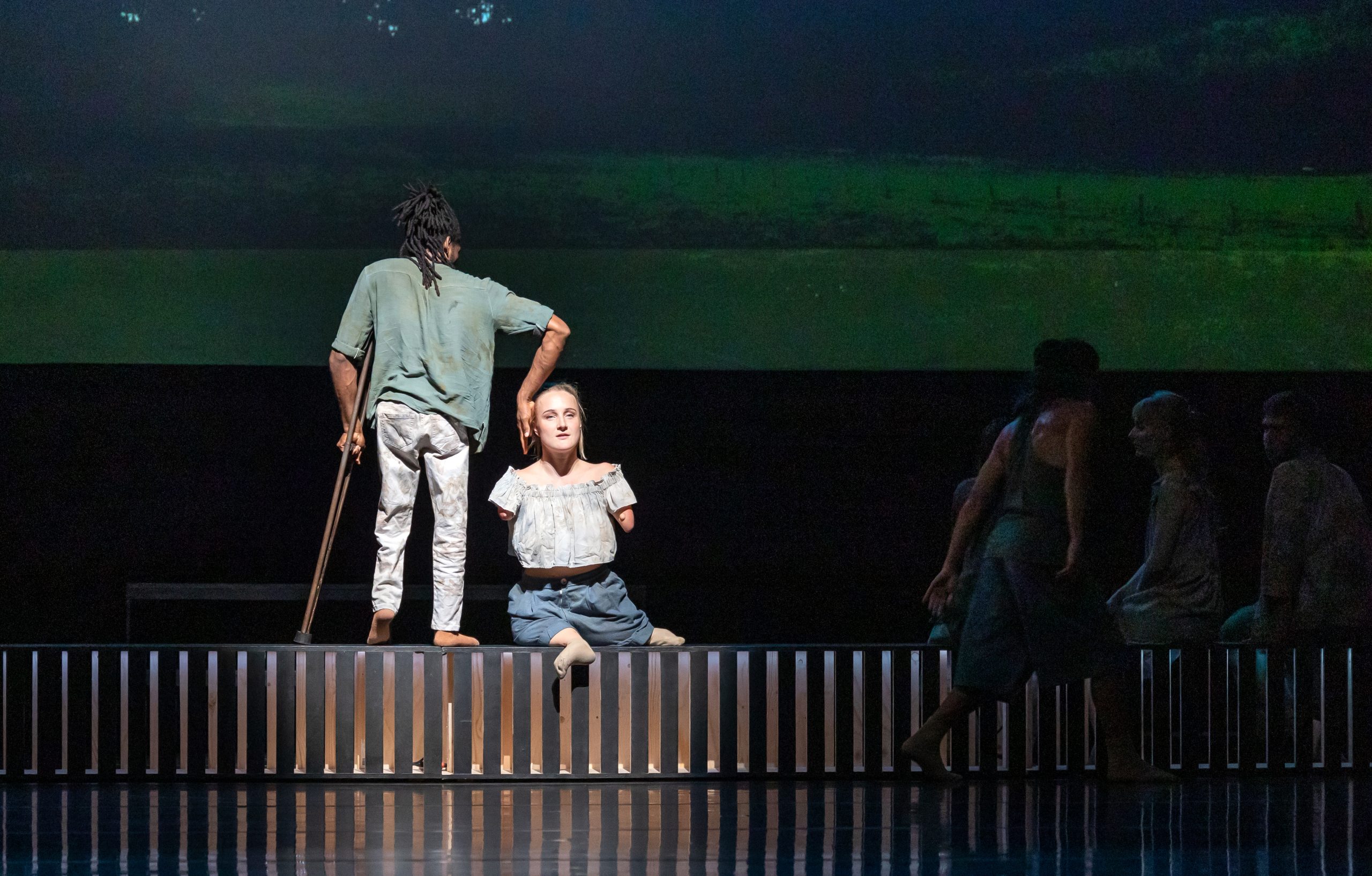Interview Support Magazine: As a dancer, I don't have to be someone I'm not.
November 30, 2024
Text by Robin Wubben
Iungo is the Latin word for ‘I connect,’ and that’s exactly what Introdans choreographer Adriaan Luteijn aims to do with his piece of the same name. Previous versions of “Iungo” have been performed in Japan, Brazil, Indonesia, and South Africa, always featuring professional dancers alongside people with various physical, social, cultural, or intellectual backgrounds. Currently, a new version of the piece is being performed in the Netherlands with Introdans dancers and guest dancers Eva Eikhout and Joseph Tebandeke. Eva is not a stranger to the readers of *Support Magazine*. She was born without most of her arms and legs and has been a columnist and guest editor for the magazine. Joseph, from Uganda, contracted polio as a child and has limited use of his legs. He walks with crutches.
I speak with Eva and Joseph three days before the premiere, in dressing room 3 at the Amphion Theater in Doetinchem. There’s a lot of laughter. Are they already feeling the nerves? Not at all, they emphasize. They’re just enjoying themselves. “The nerves only come on the night itself, right before we go on stage,” Joseph says. Eva adds, “I can’t imagine we’ll be performing in three days.”
You met at the Body Moves Festival in South Africa. Slowly, the idea of dancing together emerged. Why?
Joseph: “It wasn’t so much Eva’s dancing that touched me, but her personality—how much she loves her body. She’s free, does what she enjoys, and wants to help everyone. I thought it should be the other way around; shouldn’t others want to help you?”
Eva: “Funny that you say that. If there’s anyone who doesn’t need help, it’s you. We live independent lives and do what we enjoy. And when Joseph dances, he is limitless. Then he’s just a dancer, not a dancer-with-a-disability.”
Joseph: “It’s all about how you move yourself in the space.”
You dance together in *Iungo*, but also with dancers without disabilities. Is that different?
Eva: “At the first rehearsals, I noticed people were uncertain about how to interact with us. There are parts we perform together with the whole group. And some movements we do differently. The choreographer, Adriaan, would say, ‘Okay, then we’ll do it the way Joseph and Eva do it.’ The way we did things became the standard.”
Joseph: “I had never experienced that before; it was an amazing feeling. The world adjusted to me, instead of me having to adjust to the world.”
Eva: “I was already familiar with this from previous collaborations with Adriaan. I immediately saw a sparkle in Joseph’s eyes.”
Joseph: “We had to study each other very closely by imitating each other’s movements. That’s how you get to know each other’s body better. And in doing so, you always find a way to do the same thing.
I heard others talking about my movements after rehearsals. They suddenly became much more aware of their own bodies too.”
Eva: “In the Netherlands, we talk a lot. Here, we feel more and are much more consciously focused on movement. You don’t need to explain anything. Just look at what the other person is doing and do that, feel that.”
How did you actually get started with dancing?
Eva: “During the COVID period, Introdans started doing online shows. I got in touch with Adriaan through various connections, and I did some presenting work around those shows. After a while, he asked, ‘Would you like to come dance?’ I thought it would just be a one-time thing, but before I knew it, I was rehearsing every day for six weeks. I really didn’t see that coming.”
Joseph: “I was a para-athlete. After one of the training sessions, a girl came up to me and asked if I had any ideas for what she could do because sports were difficult for her due to her body. That stuck with me. Two weeks later, I was invited to a festival where someone was giving a dance workshop. She told me that everyone could dance and gave me all kinds of information. She said, ‘You can do it too, even with a disability!’ I started to look into it, took classes, and got involved. And now I’ve ended up here in one way or another.”
Eva laughs: “I recognize that feeling. At first, I really had no idea what I was doing. How on earth did I end up here?”
First and foremost, you want to present a beautiful performance. But do you also want to convey a message to the audience?
Joseph: “That’s difficult. Everyone in the audience will see it in their own way. Everyone brings their own personality to the theater, sees things through their own eyes, and has their own background.”
Eva: “But it’s nice that we are part of the regular repertoire of Introdans; it’s not a separate show. That feels very inclusive. I need the other dancers, and they need me; we do this together.” After a brief pause, Eva adds: “It would be nice if someone sees us dance and thinks, ‘Hey, that’s possible.’ If someone suddenly sees the possibilities. But that’s a bonus. First and foremost, we want to dance.”
Eva has been dancing with Introdans longer, while for Joseph, this is his first time participating. Have you learned anything from each other?
Joseph: “Eva’s self-acceptance is truly on a different level. She always has fun; she doesn’t care what people think, she’s just herself. I’ve learned that from her. If you’re constantly worried about how society sees you, you limit yourself.”
Eva: “From Joseph, I’ve learned to focus on what my body can do. When I danced with dancers without disabilities, it sometimes felt like they primarily had to support me. With Joseph, it feels more equal. The starting point is our bodies and what we can do. I don’t have to be someone I’m not when I dance.”

